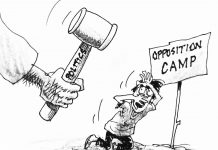
The age-old adage “one bad apple spoils the bunch” holds profound wisdom when applied to team dynamics in various settings, from workplaces to social groups. This metaphorical expression encapsulates the notion that the negative influence of a single individual can have far-reaching consequences on the entire group. Understanding how one bad apple can affect the whole bunch is essential for fostering a positive team environment and maximizing collective success.
1. Influence on Team Morale:
The presence of a toxic or disruptive individual within a team can significantly impact team morale. Negative attitudes, conflicts, and disruptive behaviors can create a sense of tension and unease among team members, leading to decreased motivation, engagement, and overall satisfaction. The negative energy emanating from the bad apple can permeate the entire group, affecting interpersonal relationships and collaboration.
During tough times, leaders can boost team morale by fostering open communication, prioritizing well-being, recognizing achievements, nurturing team connections, and inspiring hope with a shared vision. Consistency, empathy, and authenticity are key to supporting employees effectively through challenges and maintaining a resilient team spirit.
2. Productivity and Performance:
A single bad apple can have a detrimental effect on the productivity and performance of the entire team. Disruptive behaviors, lack of cooperation, and conflicts instigated by the toxic individual can impede progress, hinder decision-making processes, and create inefficiencies in task execution. The presence of a bad apple can derail the team from achieving its goals and delivering optimal results.
Enhancing team productivity and performance involves implementing strategies such as setting clear goals, providing adequate resources and support, fostering open communication, offering opportunities for skill development, recognizing and rewarding achievements, promoting collaboration, and ensuring a positive work culture. These initiatives help motivate team members, optimize their skills, and drive overall success.
3. Erosion of Trust and Communication:
Trust and effective communication are fundamental pillars of successful teamwork. However, the presence of a bad apple can erode trust among team members and disrupt open communication channels. Distrust, miscommunication, and conflicts arising from the negative influence of one individual can hinder collaboration, diminish cohesion, and create a toxic work environment.
To prevent the erosion of trust and communication within a team, it is essential to prioritize open and transparent communication, actively listen to team members, address conflicts promptly and constructively, foster a culture of respect and empathy, provide regular feedback, encourage collaboration, and ensure that all team members feel valued and heard. By consistently nurturing trust and communication, teams can maintain strong relationships and effectively work together towards common goals.
4. Ripple Effect on Team Dynamics:
The impact of one bad apple extends beyond direct interactions with other team members. The negative behaviors and attitudes of the toxic individual can spread like a contagion, influencing the behavior of other team members. This ripple effect can lead to a gradual decline in overall team dynamics, with other members adopting similar negative traits or behaviors, further exacerbating the detrimental impact on the group.
To prevent the negative ripple effect on team dynamics, it is crucial to address issues promptly, provide clear communication, encourage open dialogue, foster a supportive and inclusive environment, promote teamwork and collaboration, set clear expectations, offer continuous feedback, and prioritize conflict resolution through constructive discussions. By proactively managing team dynamics, potential ripple effects can be mitigated, ensuring a harmonious and productive work environment.
5. Leadership Challenges:
Managing a bad apple within a team poses significant challenges for team leaders and managers. Addressing disruptive behaviors, resolving conflicts, and maintaining team cohesion in the presence of a toxic individual require strong leadership skills, effective conflict resolution strategies, and a proactive approach to fostering a positive team culture. Failure to address the issue promptly can lead to escalating tensions and further disruptions within the team.
Overcoming leadership challenges requires self-awareness, continuous learning, adaptability, effective communication, building strong relationships, seeking feedback, delegating tasks, fostering a positive work culture, inspiring and motivating teams, making tough decisions, and seeking mentorship or coaching. By actively addressing and learning from challenges, leaders can grow, enhance their leadership skills, and effectively navigate complex situations.
In conclusion, the analogy of “one bad apple spoils the bunch” underscores the profound influence of negative individuals on team dynamics and collective success. Recognizing the impact of a toxic individual on team morale, productivity, trust, communication, and overall dynamics is crucial for mitigating the negative consequences and fostering a harmonious and productive team environment. By addressing disruptive behaviors, promoting positive interactions, and cultivating a culture of respect and collaboration, teams can effectively neutralize the influence of a bad apple and thrive collectively.
————–
If you have any questions or would like to share your thoughts on the column, feel free to send an email to jca.bblueprint@gmail.com. Looking forward to connecting with you!



